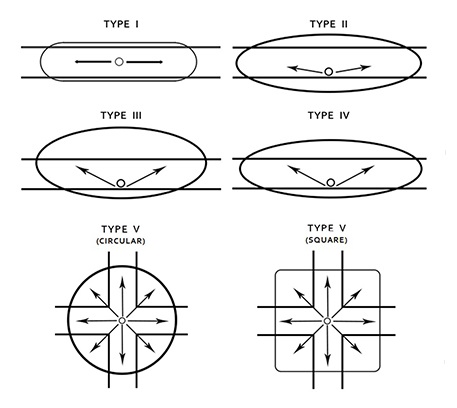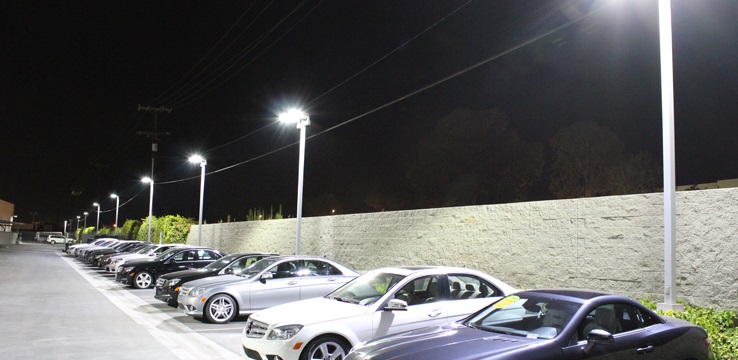Harsh and Hazardous Location lighting Manufacturer
[email protected] +86-25-85508029
Submit a Request
How to Optimize Your Parking Lot Lighting
The light distribution of a wall pack or an LED shoebox fixture plays a key role in deciding which fixture to use and where to use it. To assist in the selection of the appropriate fixture, here are six different types of light distribution to get the most out of your lighting fixture.
1. Type I: A two way lateral width distribution ideal for lighting walkways, paths, and sidewalks.
2. Type II: A lateral width distribution ideal for wide walkways, ramps, and entrance roadways.
3. Type III: A lateral width distribution ideal for roadway lighting and parking areas.
4. Type IV: A lateral width distribution ideal for perimeter parking areas and businesses.
5. Type V: A circular distribution ideal for roadways and commercial parking lots.
6. Type VS: A square distribution ideal for intersections, a large parking lot, and center roadways.

Mounting height for parking lot lights can range from 12 ft. to 20 ft. but in some cases can reach as high as 35 ft. The spacing between parking lot lights depend on the mounting height, the higher the fixture the fewer the poles needed to light an equivalent area. The lumen output of the parking lot fixture should also be considered when the adequate height and spacing are finalized. Although a high lumen output is frequently preferred for banks and car dealerships, be mindful of the utilization of the lumen output. In 2007, the Illuminating Engineering Society of North America (IES), adopted a luminaire classification system called B.U.G. (Backlight, Uplight, and Glare). B.U.G. is a rating system which determines how much and in which direction the light is being given off. To determine the B.U.G. value, the maximum lumens emitted in different sub-zones is given a value. B.U.G. values are becoming a standard in identifying how well a certain light fixture controls stray light in comparison from other lighting fixtures.
Design is important not only for the light fixture, but the surrounding area needing illumination. Landscaping and nature like trees must be taken into consideration to determine a suitable location for the luminaire to avoid any unwanted shadows. For applications that require lighting closer to buildings, wall packs can be an effective source of lighting near entry ways and door ways. In applications like covered parking garages or solar canopies, fewer parking garage fixtures at a lower lumen output can be utilized because the light is closer to the parking space.

Light Quality Light quality requirements for parking lots vary depending on the amount of traffic, time of day, and use of the space. For example a parking lot for a recreational park has doesn’t require as much illumination as a parking lot for a bank. Consider the ideal lumen output and the kelvin color temperature that is preferred for your situation. HID bulbs such as Metal Halide and High Pressure Sodium fixtures, which are frequently used for parks, tend to have a warmer color temperature (yellow/orange glow). LED bulbs typically emit a cooler color temperature (white/blue glow) making them a better fit for high security applications like banks or car dealerships. Light is measured by a source of light which falls on a given surface which is represented as a foot candle (fc). From a candela light source, a light falling on a one square foot of area is equal to one lumen per square foot. For basic light coverage, a range of 0.2 fc to 1 fc is preferred but for applications that require more coverage, 4 fc can be beneficial.
More light does not necessarily equate to better quality light, rather an appearance of overall uniform light will avoid a contrast between bright and darker areas. Uniformity is expressed as a ratio between the lowest light level reading and average light level of a specific area. If an average light level would equate to 4 fc and the lowest light level would read 1 fc, the ratio would be expressed as 4:1. Typically we would recommend a ratio of 3:1 for most parking lots. Even security cameras rated for low and high light levels have difficulty if contrast ranges are too high. This can be caused by inadequate lighting, or lighting placed too close to the camera, causing glare. If uniformity was an issue, the image perceived by a security camera would contain, “cool spots” (areas of darkness) and, “hot spots” (areas of brightness) where the details would not be seen. A contrast of light makes it difficult for vehicle and pedestrian interaction, creating an unsafe environment. Avoid this problem by using parking lot lights that create uniform lighting around the entire lot.
Efficiency As technology advances, commercial lighting fixtures have developed to yield significant energy efficient gains. LED light fixtures have revolutionized how the world sees lighting. LED lighting is synonymous with energy efficiency because LED lights consume drastically less energy than traditional HID lighting fixtures. The next step towards creating an energy efficient parking lot is installing lighting controls. The most common parking lot light controls are,
In order to increase energy efficiency organizations like the Lighting Energy Efficiency in Parking and the Federal Energy Management Program (FEMP) created the tools and guides for implementing these cost-saving methods into parking lot lighting. As of today there is no one way to illuminate a parking lot but, with the guidance provided from FEMP and LEEP, there is a push towards an energy efficient future.

